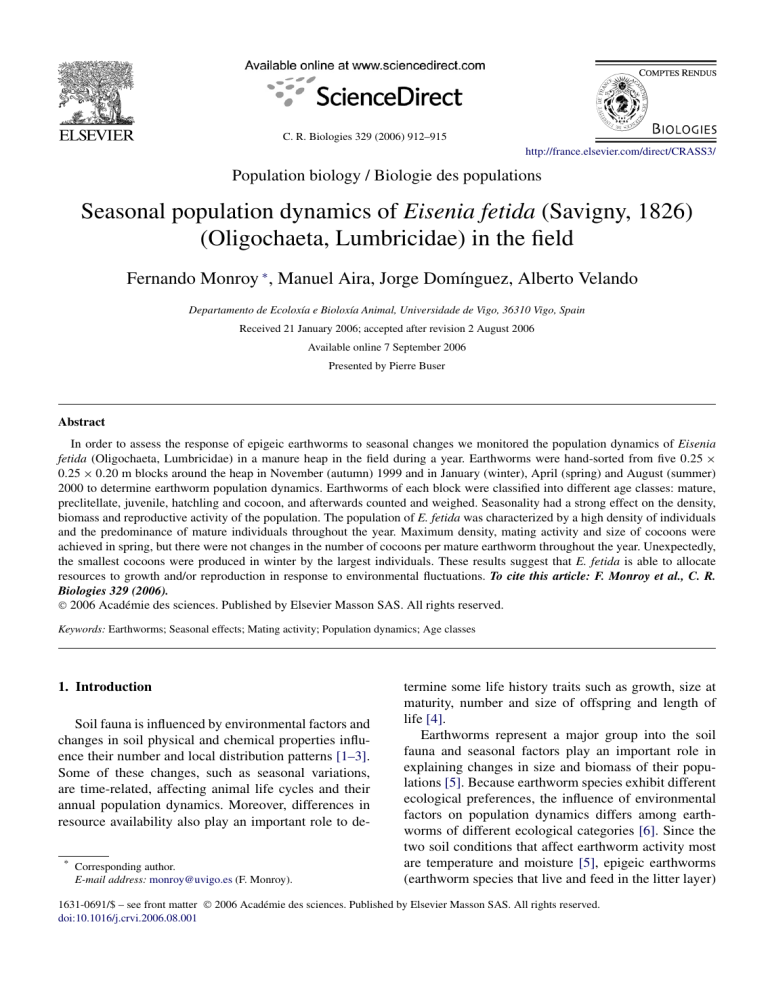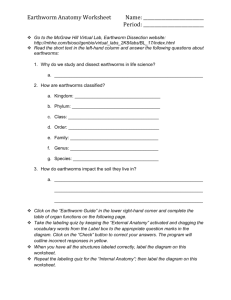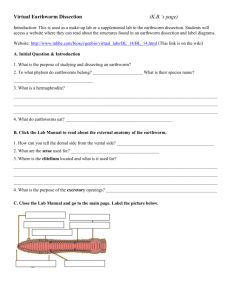
C. R. Biologies 329 (2006) 912–915
http://france.elsevier.com/direct/CRASS3/
Population biology / Biologie des populations
Seasonal population dynamics of Eisenia fetida (Savigny, 1826)
(Oligochaeta, Lumbricidae) in the field
Fernando Monroy ∗ , Manuel Aira, Jorge Domínguez, Alberto Velando
Departamento de Ecoloxía e Bioloxía Animal, Universidade de Vigo, 36310 Vigo, Spain
Received 21 January 2006; accepted after revision 2 August 2006
Available online 7 September 2006
Presented by Pierre Buser
Abstract
In order to assess the response of epigeic earthworms to seasonal changes we monitored the population dynamics of Eisenia
fetida (Oligochaeta, Lumbricidae) in a manure heap in the field during a year. Earthworms were hand-sorted from five 0.25 ×
0.25 × 0.20 m blocks around the heap in November (autumn) 1999 and in January (winter), April (spring) and August (summer)
2000 to determine earthworm population dynamics. Earthworms of each block were classified into different age classes: mature,
preclitellate, juvenile, hatchling and cocoon, and afterwards counted and weighed. Seasonality had a strong effect on the density,
biomass and reproductive activity of the population. The population of E. fetida was characterized by a high density of individuals
and the predominance of mature individuals throughout the year. Maximum density, mating activity and size of cocoons were
achieved in spring, but there were not changes in the number of cocoons per mature earthworm throughout the year. Unexpectedly,
the smallest cocoons were produced in winter by the largest individuals. These results suggest that E. fetida is able to allocate
resources to growth and/or reproduction in response to environmental fluctuations. To cite this article: F. Monroy et al., C. R.
Biologies 329 (2006).
© 2006 Académie des sciences. Published by Elsevier Masson SAS. All rights reserved.
Keywords: Earthworms; Seasonal effects; Mating activity; Population dynamics; Age classes
1. Introduction
Soil fauna is influenced by environmental factors and
changes in soil physical and chemical properties influence their number and local distribution patterns [1–3].
Some of these changes, such as seasonal variations,
are time-related, affecting animal life cycles and their
annual population dynamics. Moreover, differences in
resource availability also play an important role to de* Corresponding author.
E-mail address: monroy@uvigo.es (F. Monroy).
termine some life history traits such as growth, size at
maturity, number and size of offspring and length of
life [4].
Earthworms represent a major group into the soil
fauna and seasonal factors play an important role in
explaining changes in size and biomass of their populations [5]. Because earthworm species exhibit different
ecological preferences, the influence of environmental
factors on population dynamics differs among earthworms of different ecological categories [6]. Since the
two soil conditions that affect earthworm activity most
are temperature and moisture [5], epigeic earthworms
(earthworm species that live and feed in the litter layer)
1631-0691/$ – see front matter © 2006 Académie des sciences. Published by Elsevier Masson SAS. All rights reserved.
doi:10.1016/j.crvi.2006.08.001
F. Monroy et al. / C. R. Biologies 329 (2006) 912–915
are probably much more affected by the season than endogeic or anecic species (those that inhabit permanent
or semipermanent burrow systems into the soil). Eisenia fetida (Savigny, 1826) is an epigeic species associated to environments with high organic matter content
and their natural populations live at high densities in
patchy distributions [7]. The basic aspects of the life cycle of E. fetida are relatively well documented due to the
importance of this species in waste management. The
growth and reproduction of this earthworm species is affected by several factors such as food quality, moisture,
temperature and population density, as showed under
laboratory conditions (see [8] for a review). Moreover
E. fetida is an iteroparous earthworm, with continuous
and high reproduction rates, and it should respond to adverse environmental conditions modifying those rates.
Partly due to the particular distribution of this species, mainly associated to compost and manure piles [9],
there is only one study regarding its seasonal cycle [10].
The present work was undertaken to study the effect of
seasonality on the changes of density, biomass and reproductive activity of the earthworm E. fetida in a field
population.
913
heap was removed as every year in late spring to use it as
source of organic matter in agricultural fields. In order
to know the age distribution of the population, earthworms collected from each sample were separated in the
laboratory into mature (with well-developed clitellum),
preclitellate (with tubercula pubertatis), juvenile, and
hatchling (<0.01 g) stages. Earthworms were counted
and weighed during each seasonal sampling. Cocoons
were also counted and weighed from a subsample of
100 g of substrate. Average cocoon deposition per earthworm was estimated for each season from densities of
cocoons and mature individuals. Mature earthworms
were checked in the laboratory, using a dissecting microscope, for the presence of spermatophores, which indicates a recent mating [13]. Therefore, mating activity
was estimated as the percentage of mature individuals
with spermatophores.
Statistical analyses of earthworm data were done
using SPSS (version 11.0.1) for Windows. Prior to
the analysis, sampled values were normalized using a
log(x + 1) transformation. The effect of the season was
analyzed by one-way ANOVA with the GLM procedure
of SPSS. Post hoc comparisons between the different
seasons were performed using the Tukey HSD test.
2. Materials and methods
3. Results
Individuals of E. fetida were collected in a temporary heap of cow manure from a small farm near the
University of Vigo (42◦ 9 N, 8◦ 41 W), in the northwest
of Spain. Average annual rainfall and temperature in the
zone range between 2500–3000 mm and 11–12 ◦ C respectively, with lower rainfall and higher temperatures
reached in the summer [11,12]. Nevertheless, during the
sampling period, the total precipitation was 1820 mm,
as is referred in Table 1. The population of E. fetida was
limited to the manure heap, since this epigeic species
is scarce or absent in soils without direct presence
of organic amendments [7]. Earthworms were handsorted from five 0.25 × 0.25 × 0.20-m blocks around the
heap in November (autumn) 1999, January (winter) and
April (spring) 2000 to determine earthworm population
dynamics. Summer samples were collected in August
2000 using only two blocks, since most of the manure
Table 1
Total rainfall and average temperature in the study area on sampling
dates
Autumn 1999
Winter 1999
Spring 2000
Summer 2000
Rainfall (mm)
Temperature (◦ C)
600
200
770
250
9.1 ± 1.6
8.1 ± 1.7
12.1 ± 2.7
16.0 ± 0.3
The density of E. fetida in the field population across
all seasons was 4950 ± 690 individuals m−2 , with a biomass of 1040 ± 130 g live weight m−2 . Most of the
biological traits of this population strongly changed
through the year (Table 2). The number of earthworms
increased significantly from autumn to spring, when the
population showed its maximum density. In summer,
the earthworm population density decreased until the
lowest numbers. Earthworm biomass followed a similar seasonal trend, with the highest value in spring and
the lowest in summer (Table 2). The density and the average weight of the cocoons were significantly higher in
spring and lower in winter (Table 2).
The age structure of the population also changed
over time. The mature-to-juvenile ratios were 11.4, 1.4,
1.7 and 0.1 for autumn, winter, spring and summer, respectively. The proportion of mature earthworms was
almost constant during autumn, winter and spring and
was very low during the summer, when almost 80% of
the individuals were juveniles; the highest numbers of
hatchlings were found in spring (Table 2). Mature, preclitellate and juvenile earthworms were larger in winter
and autumn than in spring and summer (Table 2). Mature earthworms bearing spermatophores were present
in the population during the whole year and were more
914
F. Monroy et al. / C. R. Biologies 329 (2006) 912–915
Table 2
Effect of the season (GLM test) on the density, biomass and reproductive activity of a field population of the earthworm Eisenia fetida (Oligochaeta,
Lumbricidae)
Autumn
Total earthworms (No. m−2 )
Mature (No. m−2 )
Preclitellate (No. m−2 )
Juvenile (No. m−2 )
Hatchling (No. m−2 )
Cocoon (No. m−2 )
Total biomass (g live weight m−2 )
Mature weight (g individual−1 )
Preclitellate weight (g individual−1 )
Juvenile weight (g individual−1 )
Cocoon weight (mg unit−1 )
Mating activity (%)
No. cocoon adult−1
2450 ± 250a
1680 ± 380a
540 ± 90a
150 ± 55a
Not sampled
Not sampled
775 ± 150a
0.33 ± 0.02ab
0.28 ± 0.03a
0.15 ± 0.02a
Not calculated
10.5 ± 4.1ab
Not calculated
Winter
3965
1760
540
1250
410
850
980
0.40
0.25
0.10
12.03
3.8
0.4
Spring
± 490a
± 370a
± 110a
± 280b
± 160a
± 400a
± 180ab
± 0.02a
± 0.01ab
± 0.01a
± 1.36a
± 1.5a
± 0.1a
8460
3810
790
2280
1650
3970
1570
0.32
0.21
0.09
22.57
22.1
1.1
± 1000b
± 480a
± 150a
± 680b
± 500a
± 1090b
± 240b
± 0.01b
± 0.01b
± 0.01a
± 1.37b
± 1.6b
± 0.3a
Summer
4888
432
504
3488
464
184
527
0.29
0.22
0.08
19.12
4.9
0.6
±
±
±
±
±
±
±
±
±
±
±
±
±
Seasonal effect
1528ab
224b
24a
1552b
224a
24a
31a
0.01b
0.02ab
0.01a
0.01b
4.9ab
0.4a
df
3
3
3
3
2
2
3
3
3
3
2
3
2
F
14.04
10.00
0.47
18.34
2.01
15.40
4.60
5.87
3.36
3.49
17.03
5.20
2.72
P
<0.001
0.001
0.710
<0.001
0.190
0.001
0.021
0.009
0.052
0.047
<0.001
0.014
0.119
Values are means ± SE (n = 5 for autumn, winter and spring; n = 2 for summer). Different letters indicate significant differences (Tukey HSD test,
α = 0.05).
abundant in spring (Table 2). Mating activity was significantly higher in spring and autumn. The number of
cocoons per mature earthworm was similar throughout
the year (Table 2).
4. Discussion
Seasonality had a strong influence on the growth and
reproduction of E. fetida and consequently on the age
structure of the population. This population was characterized by a very high density and biomass with a
high proportion of mature individuals throughout the
year. This resulted in an unusual population structure
where the young earthworms were not the most abundant stage, as in other earthworm species [5]. High densities are common in E. fetida populations when large
quantities of organic matter are available, supporting up
to 14 600 individuals m−2 [7]. Moreover, E. fetida lives
in environments where the food and the living substrate
usually are the same [9] and this resource availability
should improve the conditions for earthworm growth
and reproduction, and promote the occurrence of high
numbers of mature individuals.
In our study, the average size of the mature earthworms ranged between 0.30 and 0.40 g, as it was
reported by Watanabe and Tsukamoto [10], although
E. fetida can reach nearly 1.6 g in laboratory conditions [14]. The low mean annual temperature in the
study area (11–12 ◦ C) could explain the observed size
of the mature earthworms [15]. Furthermore, the high
population density likely had a strong effect on mature
weight, since Neuhauser et al. [16] and Reinecke and
Viljoen [17] reported a weight of adult individuals be-
low 0.40 g for population densities equivalent to 2000
and 2700 individuals m−2 , respectively.
Unexpectedly, maximum mean weight of adult earthworms was achieved in winter, at the lowest temperatures, but these large-sized earthworms showed the lowest mating activity. Temperature regimes below 15 ◦ C
cause low growth rates [18], but also affect to reproduction diminishing cocoon production and increasing
incubation time [15,19]. The low reproductive activity found in winter could lead to weight gain due to
decrease of reproductive costs and reallocation of resources toward growth [4]. According to this, the mean
weight of the mature earthworms decreased in spring
with the increasing reproductive activity. Similar results
for resource reallocation to growth were reported by
Cluzeau et al. [20] when adult individuals of E. fetida
were isolated or reared in groups after mating.
The decline of the mature stage in summer was another feature of the population of E. fetida. The marked
decrease in density of mature earthworms was probably
caused by the strong disturbance caused by the removal
of most of the manure in late spring. After this event,
small juvenile and newly hatched individuals became
the most abundant stages in the summer population.
Mating processes and production of cocoons in the
population of E. fetida occurred throughout the whole
year, indicating that there were some favourable and
stable conditions to reproduction, even in winter. According to this, in the studied population there was not
seasonal effect in the number of cocoons relative to the
number of adult earthworms, although the highest mating activity occurred in spring. This mating peak could
be due either to the optimal environmental conditions
F. Monroy et al. / C. R. Biologies 329 (2006) 912–915
that lead to a maximum in the population traits measured or to an increase in the number of available mates.
In fact, the availability of mates is one of the factors
involved in the size-assortative mating of earthworms
[21,22].
Changes in the density of cocoons over time seem to
be related with the density of mature earthworms, despite the lack of significance in their density between
winter and spring. These results agree with those of
Watanabe and Tsukamoto [10], who found that cocoons
were recorded mainly in autumn and spring, being affected by both the high and low temperatures in summer
and winter, respectively. We found that cocoons were
smaller in winter and larger in spring, and it is interesting to note that the smaller cocoons were produced
by the heavier mature earthworms. Then our data suggest that E. fetida is able to regulate cocoon size in
response to environmental factors. Currently, it remains
unclear whether the size of earthworms is the only factor governing cocoon size [14,23,24], but in E. fetida the
weight of the cocoon influences the number of progeny
per cocoon [10,23,25]. We suggest that this ability to
regulate the size of the cocoons has important implications in the development of the population. Thus, although in our study there are no significant differences
in the number of cocoons in relation to the number of
adult individuals between seasons, changes in offspring
production and population growth rates can occur anyway.
Acknowledgements
This research was supported by CICYT (AGL200301570) and Xunta de Galicia (PGIDIT03PXIB30102PR)
grants.
References
[1] C.H. Ettema, D.C. Coleman, G. Vellidis, R. Lowrance, S.L.
Rathbun, Spatiotemporal distributions of bacterivorous nematodes and soil resources in a restored riparian wetland, Ecology 79 (1998) 2721–2734.
[2] C.H. Ettema, D.A. Wardle, Spatial soil ecology, Trends Ecol.
Evol. 17 (2002) 177–183.
[3] J.P. Rossi, Short-range structures in earthworm spatial distribution, Pedobiologia 47 (2003) 582–587.
[4] S.C. Stearns, The Evolution of Life Histories, Oxford University
Press, Oxford, 1992.
[5] C.A. Edwards, P.J. Bohlen, Biology and Ecology of Earthworms,
Chapman & Hall, London, 2004.
[6] A. Rozen, The annual cycle in populations of earthworms (Lumbricidae Oligochaeta) in three types of oak-hornbeam of the
Niepolomicka Forest II. Dynamics of population numbers, biomass and age structure, Pedobiologia 31 (1988) 169–178.
915
[7] C. Elvira, J. Dominguez, M.J.I. Briones, Earthworm community composition in an uncontrolled rubbish dump, a pig farm
dunghill, and a deposit of primary sludges, Nova Acta Cient.
Compostel. Biol. 6 (1996) 123–129.
[8] J. Domínguez, State of the art and new perspectives on vermicomposting research, in: C.A. Edwards (Ed.), Earthworm Ecology, CRC Press, Boca Raton, FL, USA, 2004, pp. 401–424.
[9] M.-B. Bouché, Lombriciens de France, Écologie et Systématique, Ann. Zool. Ecol. Anim., INRA Publ. no. 72, Paris, 1972.
[10] H. Watanabe, J. Tsukamoto, Seasonal changes in size class and
stage structure of Lumbricid Eisenia foetida population in a field
compost and its practical application as the decomposer of organic waste matter, Rev. Ecol. Biol. Sol. 13 (1976) 141–146.
[11] C. Andrade, E. Canitrot, Anuario Climatolóxico de Galicia
(1999), Consellería de Medio Ambiente, Xunta de Galicia, Santiago de Compostela, online, URL: http://www.meteogalicia.es/
documentos/anuario99.pdf.
[12] C. Andrade, E. Canitrot, P. Barreiros, S. Salsón, Anuario Climatolóxico de Galicia, Consellería de Medio Ambiente, Xunta
de Galicia, Santiago de Compostela, 2000, online, URL: http://
www.meteogalicia.es/documentos/anuario2000pdf.
[13] F. Monroy, M. Aira, A. Velando, J. Domínguez, Have spermatophores in Eisenia fetida (Oligochaeta, Lumbricidae) any
reproductive role?, Pedobiologia 47 (2003) 526–529.
[14] J.M. Venter, A.J. Reinecke, The life-cycle of the compost worm
Eisenia fetida (Oligochaeta), S. Afr. J. Zool. 23 (1988) 161–165.
[15] J. Tsukamoto, H. Watanabe, Influence of temperature on hatching and growth of Eisenia foetida (Oligochaeta, Lumbricidae),
Pedobiologia 17 (1977) 338–342.
[16] E.F. Neuhauser, R. Hartenstein, D.L. Kaplan, Growth of the
earthworm Eisenia foetida in relation to population density and
food rationing, Oikos 35 (1980) 93–98.
[17] A.J. Reinecke, S.A. Viljoen, The influence of worm density on
growth and cocoon production of the compost worm Eisenia
fetida (Oligochaeta), Rev. Ecol. Biol. Sol. 27 (1990) 221–230.
[18] D.L. Kaplan, R. Hartenstein, E.F. Neuhauser, Physicochemical requirements in the environment of the earthworm Eisenia
foetida, Soil Biol. Biochem. 12 (1980) 347–352.
[19] A.J. Reinecke, J.R. Kriel, Influence of temperature on the reproduction of the earthworm Eisenia foetida (Oligochaeta), S. Afr.
J. Zool. 16 (1981) 96–100.
[20] D. Cluzeau, L. Fayolle, M. Hubert, The adaptation value of
reproductive strategy and mode in three epigeous earthworm
species, Soil Biol. Biochem. 24 (1992) 1309–1315.
[21] N.K. Michiels, A. Hohner, I.C. Vorndran, Precopulatory mate
assessment in relation to body size in the earthworm Lumbricus terrestris: avoidance of dangerous liaisons?, Behav. Ecol. 12
(2001) 612–618.
[22] F. Monroy, M. Aira, J. Domínguez, A. Velando, Size-assortative
mating in the earthworm Eisenia fetida (Oligochaeta, Lumbricidae), J. Ethol. 23 (2005) 69–70.
[23] R. Hartenstein, E.F. Neuhauser, D.L. Kaplan, Reproductive potential of the earthworm Eisenia foetida, Oecologia 43 (1979)
329–340.
[24] A.J. Reinecke, J.M. Venter, Moisture preferences, growth and
reproduction of the compost worm Eisenia fetida (Oligochaeta),
Biol. Fertil. Soils 3 (1987) 135–141.
[25] P.S. Sheppard, Specific differences in cocoon and hatchling production in Eisenia fetida and Eisenia andrei, in: C.A. Edwards,
E.F. Neuhauser (Eds.), Earthworms in Waste and Environmental
Management, SPB Academic Publishing BV, The Hague, The
Netherlands, 1988, pp. 83–92.



